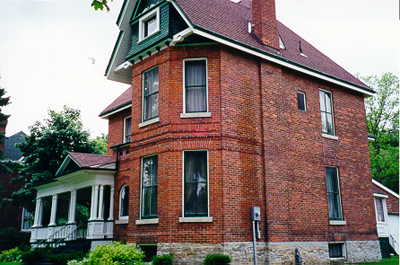Billy Bishop Boyhood Home National Historic Site of Canada
Owen Sound, Ontario

Billy Bishop Boyhood Home
© Parks Canada / Parcs Canada, 1993
Address :
948 Third Avenue West, Owen Sound, Ontario
Recognition Statute:
Historic Sites and Monuments Act (R.S.C., 1985, c. H-4)
Designation Date:
2002-11-01
Dates:
-
1884 to 1884
(Construction)
-
1894 to 1911
(Significant)
Other Name(s):
-
Billy Bishop Boyhood Home
(Designation Name)
-
Billy Bishop Heritage Museum
(Other Name)
-
WILLIAM AVERY 'BILLY' BISHOP AND HIS BOYHOOD HOME
(Plaque name)
Research Report Number:
April 2002 OB
Plaque(s)
Existing plaque: Mounted on post in front of house 948 Third Avenue West, Owen Sound, Ontario
This house is the birthplace and childhood home of Billy Bishop, the legendary flying ace who won renown with the Royal Flying Corps and Royal Air Force during the First World War. In 1917 and 1918, Bishop flew daring missions in his Nieuport and SE5 scout aircraft, and was credited with shooting down 72 enemy aircraft. He was awarded the Victoria Cross, and other medals for valour, becoming one of Canada's most decorated servicemen. Today, the house stands as a memorial to the small-town boy who became a celebrated aviation idol and remains today one of Canada's most recognized national heroes.
Description of Historic Place
Billy Bishop Boyhood Home National Historic Site is a substantial two-and-half storey brick house located in a residential neighbourhood of Owen Sound, Ontario. Typical of many middle-class Canadian homes in late 19th century towns, it is a solid brick home with minimal stylistic pretensions. The designation refers to the house on its lot.
Heritage Value
Billy Bishop Boyhood Home was designated a National Historic Site because: the birthplace and childhood home of Billy Bishop provides a link to his middle-class childhood in small-town Ontario, and is the only surviving property in Canada that is strongly associated with the renowned First World War flying ace and recipient of the Victoria Cross, and as a memorial to Billy Bishop, the home conveys his legendary status and his iconic significance for many Canadians.
The heritage value of Billy Bishop Boyhood Home National Historic Site lies in its association with the famous pilot as illustrated by the house itself and particularly the 1894-1911 period when he lived there. The value is carried by its modest design, materials, craftsmanship, layout and site, so typical of small town homes in late 19th century Canada.
Canada’s World War I flying ace Billy Bishop lived in this house from the time of his birth in 1894 until 1911. The house had been built in 1884 and continued to be occupied by Bishop’s extended family until 1987. Since then it has been open to the public as the Billy Bishop Heritage Museum.
Source: Historic Sites and Monuments Board of Canada, Minute, Fall 2000, June 2001, 2002.
Character-Defining Elements
Key elements that contribute to the heritage value of the site include: its location in a residential neighbourhood with homes of similar age and type; the typicality of the late 19th middle-class residence in a small Ontario town, in its modest Queen Anne design with irregular two-and-half storey massing, steeply pitched roof and gabled front and side bays; its modest decorative features, including generous front porch with columns and pedimented entrance, decorative shingle and trim, decorative chimney cap; its generous use of substantial, mass-produced, simply detailed materials (brick, shingle, wood); its platform frame construction; the integrity of the original interior layout, including Billy Bishop’s bedroom; surviving materials, and finishes from the Billy Bishop period; the generous size of its residential lot, with house set back from the street and surrounded by garden and lawn; evidence of surviving garden plantings, walkways and fence lines original to the Billy Bishop period; the presence of the brick garage that dates from the Billy Bishop period.